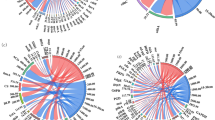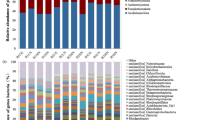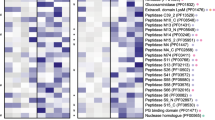Abstract
Glacier forefields are ideal ecosystems to study the development of nutrient cycles as well as single turnover processes during soil development. In this study, we examined the ecology of the microbial nitrogen (N) cycle in bulk soil samples from a chronosequence of the Damma glacier, Switzerland. Major processes of the N cycle were reconstructed on the genetic as well as the potential enzyme activity level at sites of the chronosequence that have been ice-free for 10, 50, 70, 120 and 2000 years. In our study, we focused on N fixation, mineralization (chitinolysis and proteolysis), nitrification and denitrification. Our results suggest that mineralization, mainly the decomposition of deposited organic material, was the main driver for N turnover in initial soils, that is, ice-free for 10 years. Transient soils being ice-free for 50 and 70 years were characterized by a high abundance of N fixing microorganisms. In developed soils, ice-free for 120 and 2000 years, significant rates of nitrification and denitrification were measured. Surprisingly, copy numbers of the respective functional genes encoding the corresponding enzymes were already high in the initial phase of soil development. This clearly indicates that the genetic potential is not the driver for certain functional traits in the initial phase of soil formation but rather a well-balanced expression of the respective genes coding for selected functions.
Similar content being viewed by others
Log in or create a free account to read this content
Gain free access to this article, as well as selected content from this journal and more on nature.com
or
References
Babic KH, Schauss K, Hai B, Sikora S, Redzepovic S, Radl V et al. (2008). Influence of different Sinorhizobium meliloti inocula on abundance of genes involved in nitrogen transformations in the rhizosphere of alfalfa (Medicago sativa L.). Environ Microbiol 10: 2922–2930.
Bach HJ, Hartmann A, Schloter M, Munch JC . (2001). PCR primers and functional probes for amplification and detection of bacterial genes for extracellular peptidases in single strains and in soil. J Microbiol Meth 44: 173–182.
Bardgett RD, Walker LR . (2004). Impact of coloniser plant species on the development of decomposer microbial communities following deglaciation. Soil Biol Biochem 36: 555–559.
Bardgett RD, Richter A, Bol R, Garnett MH, Baumler R, Xu XL et al. (2007). Heterotrophic microbial communities use ancient carbon following glacial retreat. Biol Lett 3: 487–490.
Bernasconi SM . (2008). Weathering, soil formation and initial ecosystem evolution on a glacier forefield: a case study from the Damma Glacier, Switzerland. Mineral Mag 72: 19–22.
Braker G, Fesefeldt A, Witzel K . (1998). Development of PCR primer systems for amplification of nitrite reductase genes (nirK and nirS) to detect denitrifying bacteria in environmental samples. Appl Environ Microbiol 64: 3769–3775.
Cabrera ML, Beare MH . (1993). Alkaline persulfate oxidation for determining total nitrogen in microbial biomass extracts. Soil Sci Soc Am J 57: 1007–1012.
Chapin FS, Walker FS, Fastie CL, Sharman LC . (1994). Mechanisms of primary succession following deglaciation at Glacier Bay, Alaska. Ecol Monogr 64: 149–175.
Chronakova A, Radl V, Cuhel J, Simek M, Elhottova D, Engel M et al. (2009). Overwintering management on upland pasture causes shifts in an abundance of denitrifying microbial communities, their activity and N2O-reducing ability. Soil Biol Biochem 41: 1132–1138.
Cohen-Kupiec R, Chet I . (1998). The molecular biology of chitin digestion. Curr Opin Biotechnol 9: 270–277.
De Boer W, Kowalchuk GA . (2001). Nitrification in acid soils: micro-organisms and mechanisms. Soil Biol Biochem 33: 853–866.
Deiglmayr K, Philippot L, Tscherko D, Kandeler E . (2006). Microbial succession of nitrate-reducing bacteria in the rhizosphere of Poa alpina across a glacier foreland in the Central Alps. Environ Microbiol 8: 1600–1612.
Di HJ, Cameron KC, Shen JP, Winefield CS, O′Callaghan M, Bowatte S et al. (2009). Nitrification driven by bacteria and not archaea in nitrogen-rich grassland soils. Nat Geosci 2: 621–624.
Di HJ, Cameron KC, Shen JP, Winefield CS, O′Callaghan M, Bowatte S et al. (2010). Ammonia oxidizing bacteria and archaea grow under contrasting soil nitrogen conditions. FEMS Microbiol Ecol 72: 386–394.
Duc L, Noll M, Meier BE, Burgmann H, Zeyer J . (2009). High Diversity of diazotrophs in the forefield of a receding alpine glacier. Microb Ecol 57: 179–190.
Edwards IP, Burgmann H, Miniaci C, Zeyer J . (2006). Variation in microbial community composition and culturability in the rhizosphere of Leucanthemopsis alpina L Heywood and adjacent bare soil along an alpine chronosequence. Microb Ecol 52: 679–692.
Eparvier A, Lemanceau P, Alabouvette C . (1991). Population dynamics of non-pathogenic Fusarium and fluorescent Pseudomonas strains in rockwool, a substratum for soilless culture. FEMS Microbiol Lett 86: 177–184.
Ferderal Commission for Air Hygiene. (2005). Stickstoffhaltige Luftschadstoffe in der Schweiz, Schriftenreihe Umwelt Nr. 384. Federal Office for the Environment: Bern.
Frank DA, Groffman PM, Evans RD, Tracy BF . (2000). Ungulate stimulation of nitrogen cycling and retention in Yellowstone Park grasslands. Oecologia 123: 116–121.
Fuka MM, Engel M, Gattinger A, Bausenwein U, Sommer M, Munch JC et al. (2008). Factors influencing variability of proteolytic genes and activities in arable soils. Soil Biol Biochem 40: 1646–1653.
Hallin S, Jones CM, Schloter M, Philippot L . (2009). Relationship between N-cycling communities and ecosystem functioning in a 50-year-old fertilization experiment. ISME J 3: 597–605.
Hammerli A, Waldhuber S, Miniaci C, Zeyer J, Bunge M . (2007). Local expansion and selection of soil bacteria in a glacier forefield. Eur J Soil Sci 58: 1437–1445.
Hendel B, Marxsen J . (2005). Fluorometric determination of the activity of beta-glucosidase and other extracellular hydrolytic enzymes. In: Graça, MAS, Bärlocher F, Gessner MO (eds). Methods to study litter decomposition. Springer: Dordrecht, pp 261–266.
Henry S, Baudoin E, López-Gutiérrez JC, Martin-Laurent F, Brauman A, Philippot L . (2004). Quantification of denitrifying bacteria in soils by nirK gene targeted real-time PCR. J Microbiol Meth 59: 327–335.
Henry S, Bru D, Stres B, Hallet S, Philippot L . (2006). Quantitative detection of the nosZ gene, encoding nitrous oxide reductase, and comparison of the abundances of 16S rRNA, narG, nirK, and nosZ genes in soils. Appl Environ Microbiol 72: 5181–5189.
Hodkinson ID, Webb NR, Coulson SJ . (2002). Primary community assembly on land – the missing stages: why are the heterotrophic organisms always there first? J Ecol 90: 569–577.
Hoffmann H, Schloter M, Wilke BM . (2007). Microscale-scale measurement of potential nitrification rates of soil aggregates. Bio Fert Soils 44: 411–413.
Joergensen RG . (1996). The fumigation-extraction method to estimate soil microbial biomass: Calibration of the k(EC) value. Soil Biol Biochem 28: 25–31.
Kandeler E, Deiglmayr K, Tscherko D, Bru D, Philippot L . (2006). Abundance of narG, nirS, nirK, and nosZ genes of denitrifying bacteria during primary successions of a glacier foreland. Appl Environ Microbiol 72: 5957–5962.
Kohls SJ, Vankessel C, Baker DD, Gridal DF, Lawrence DB . (1994). Assessment of N2 fixation and N cycling by dryas along a chronosequence within the forelands of the Athabasca glacier, Canada. Soil Biol Biochem 26: 623–632.
Kowalchuk GA, Stienstra AW, Heilig GH, Stephen JR, Woldendorp JW . (2000). Changes in the community structure of ammonia-oxidizing bacteria during secondary succession of calcareous grasslands. Environ Microbiol 2: 99–110.
Lazzaro A, Abegg C, Zeyer J . (2009). Bacterial community structure of glacier forefields on siliceous and calcareous bedrock. Eur J Soil Sci 60: 860–870.
Leininger S, Urich T, Schloter M, Schwark L, Qi J, Nicol GW et al. (2006). Archaea predominate among ammonia-oxidizing prokaryotes in soils. Nature 442: 806–809.
Luo J, White RE, Ball PR, Tillman RW . (1996). Measuring denitrification activity in soils under pasture: Optimizing conditions for the short-term denitrification enzyme assay and effects of soil storage on denitrification activity. Soil Biol Biochem 28: 409–417.
Maisch M . (2000). The longterm signal of climate change in the swiss alps: glacier retreat since the end of the little ice age and future ice decay scenarios. Geogr Fis Dinam Quat 23: 139–151.
Matsui K, Ishii N, Honjo M, Kawabata Z . (2004). Use of the SYBR Green I fluorescent dye and a centrifugal filter device for rapid determination of dissolved DNA concentration in fresh water. Aquat Microb Ecol 36: 99–105.
Michotey V, Méjean V, Bonin P . (2000). Comparison of methods for quantification of cytochrome cd1-denitrifying bacteria in environmental marine samples. Appl Environ Microbiol 66: 1564–1571.
National Air Pollution Monitoring Network (NABEL) (2008). NABEL-Luftbelastung 2007, Umweltzustand Nr. 0823. Federal Office for the Environment: Bern.
Nemergut DR, Anderson SP, Cleveland CC, Martin AP, Miller AE, Seimon A et al. (2007). Microbial community succession in an unvegetated, recently deglaciated soil. Microb Ecol 53: 110–122.
Nicol GW, Leininger S, Schleper C, Prosser JI . (2008). The influence of soil pH on the diversity, abundance and transcriptional activity of ammonia oxidizing archaea and bacteria. Environ Microbiol 10: 2966–2978.
Nyiri A, Gauss M, Klein H . (2009). Transboundary air pollution by main pollutants (S, N, O3) and PM. Norwegian Meteorological Institute: Oslo.
Ohtonen R, Fritze H, Pennanen T et al. (1999). Ecosystem properties and microbial community changes in primary succession on a glacier forefront. Oecologia 119: 239–246.
Olander LP, Vitousek PM . (2000). Regulation of soil phosphatase and chitinase activity by N and P availability. Biogeochemistry 49: 175–190.
Reigstad LJ, Richter A, Daims H, Urich T, Schwark L, Schleper C . (2008). Nitrification in terrestrial hot springs of Iceland and Kamchatka. FEMS Microbiol Ecol 64: 167–174.
Rheinbaben WV, Trolldenier G . (1984). Influence of plant growth on denitrification in relation to soil moisture and potassium nutrition. Z Pflanzenernähr Bodenkd 147: 730–738.
Roling WFM . (2007). Do microbial numbers count? Quantifying the regulation of biogeochemicalfluxes by population size and cellular activity. FEMS Microbiol Ecol 62: 202–210.
Rosch C, Mergel A, Bothe H . (2002). Biodiversity of denitrifying and dinitrogen-fixing bacteria in an acid forest soil. Appl Environ Microbiol 68: 3818–3829.
Rotthauwe JH, Witzel K, Liesack W . (1997). The ammonia monooxygenase structural gene amoA as a functional marker: molecular fine-scale analysis of natural ammonia-oxidizing populations. Appl Environ Microbiol 63: 4704–4712.
Schauss K, Focks A, Leininger S, Kotzerke A, Heuer H, Thiele-Bruhn S et al. (2009). Dynamics and functional relevance of ammonia-oxidizing archaea in two agricultural soils. Environ Microbiol 11: 446–456.
Schimel JP, Bennett J . (2004). Nitrogen mineralization: Challenges of a changing paradigm. Ecology 85: 591–602.
Schmalenberger A, Noll M . (2009). Shifts in desulfonating bacterial communities along a soil chronosequence in the forefield of a receding glacier. FEMS Microbiol Ecol 71: 208–217.
Schmidt SK, Reed SC, Nemergut DR, Grandy AS, Cleveland CC, Weintraub MN et al. (2008). The earliest stages of ecosystem succession in high-elevation (5000 metres above sea level), recently deglaciated soils. Proc R Soc B 275: 2793–2802.
Schutte UME, Abdo Z, Bent SJ, William CJ, Schneider GM, Solhein B et al. (2009). Bacterial succession in a glacier foreland of the High Arctic. ISME J 3: 1258–1268.
Sigler WV, Crivii S, Zeyer J . (2002). Bacterial succession in glacial forefield soils characterized by community structure, activity and opportunistic growth dynamics. Microb Ecol 44: 306–316.
Sigler WV, Zeyer J . (2002). Microbial diversity and activity along the forefields of two receding glaciers. Microb Ecol 43: 397–407.
Throback IN, Enwall K, Jarvis A, Hallin S . (2004). Reassessing PCR primers targeting nirS, nirK and nosZ genes for community surveys of denitrifying bacteria with DGGE. FEMS Microbiol Ecol 49: 401–417.
Towe S, Albert A, Kleineidam K, Brankatschk R, Dumig A, Welzl G et al. (2010a). Abundance of microbes involved in nitrogen transformation in the rhizosphere of Leucanthemopsis alpina (L.) HEYWOOD grown in soils from different sites of the Damma glacier forefield. Microb Ecol 60: 762–770.
Towe S, Kleineidam K, Schloter M . (2010b). Differences in amplification efficiency of standard curves in quantitative real-time PCR assays and consequences for gene quantification in environmental samples. J Microbiol Methods 82: 338–341.
Treusch AH, Leininger S, Kletzin A, Schuster SC, Klenk HP, Schleper C . (2005). Novel genes for nitrite reductase and Amo-related proteins indicate a role of uncultivated mesophilic crenarchaeota in nitrogen cycling. Environ Microbiol 7: 1985–1995.
Tscherko D, Rustemeier J, Richter A, Wanek W, Kandeler E . (2003). Functional diversity of the soil microflora in primary succession across two glacier forelands in the Central Alps. Eur J Soil Sci 54: 685–696.
Tscherko D, Hammesfahr U, Marx MC, Kandeler E . (2004). Shifts in rhizosphere microbial communities and enzyme activity of Poa alpina across an alpine chronosequence. Soil Biol Biochem 36: 1685–1698.
Tscherko D, Hammesfahr U, Zeltner G, Kandeler E, Bocker R . (2005). Plant succession and rhizosphere microbial communities in a recently deglaciated alpine terrain. Basic Appl Ecol 6: 367–383.
Tsunogai U, Kido T, Hirota A, Ohkubo SB, Komatsu DD, Nakagawa F . (2008). Sensitive determinations of stable nitrogen isotopic composition of organic nitrogen through chemical conversion into N2O. Rapid Commun Mass Sp 22: 345–354.
Vance ED, Brookes PC, Jenkinson DS . (1987). An extraction method for measuring soil microbial biomass-C. Soil Biol Biochem 19: 703–707.
Xiang SR, Shang TC, Chen Y, Yao TD . (2009). Deposition and postdeposition mechanisms as possible drivers of microbial population variability in glacier ice. FEMS Microbiol Ecol 70: 9–20.
Walker LR, del Moral R . (2003). Primary Succession and Ecosystem Rehabilitation. Cambridge University Press: Cambridge.
Xiao X, Yin X, Lin J, Sun L, You Z, Wang P et al. (2005). Chitinase genes in lake sediments of Ardley Island, Antarctica. Appl Environ Microbiol 71: 7904–7909.
Yoshitake S, Uchida M, Koizumi H, Nakatsubo T . (2007). Carbon and nitrogen limitation of soil microbial respiration in a High Arctic successional glacier foreland near Ny-angstrom lesund, Svalbard. Polar Res 26: 22–30.
Zehr JP, Jenkins BD, Short SM, Steward GF . (2003). Nitrogenase gene diversity and microbial community structure: a cross-system comparison. Environ Microbiol 5: 539–554.
Zumft WG . (1997). Cell biology and molecular basis of denitrification. Microbiol Mol Biol Rev 61: 522–616.
Acknowledgements
The authors thank Stefano Bernasconi for stable isotope measurements and critical reviewers for their helpful comments on the manuscript. This study is part of the Transregional Collaborative Research Centre 38 (SFB/TRR 38), which is financially supported by the Deutsche Forschungsgemeinschaft (DFG, Bonn) and the Brandenburg Ministry of Science, Research and Culture (MWFK, Potsdam).
Author information
Authors and Affiliations
Corresponding author
Rights and permissions
About this article
Cite this article
Brankatschk, R., Töwe, S., Kleineidam, K. et al. Abundances and potential activities of nitrogen cycling microbial communities along a chronosequence of a glacier forefield. ISME J 5, 1025–1037 (2011). https://doi.org/10.1038/ismej.2010.184
Received:
Revised:
Accepted:
Published:
Issue date:
DOI: https://doi.org/10.1038/ismej.2010.184
Keywords
This article is cited by
-
Bacterial community network complexity and role of stochasticity decrease during primary succession
Soil Ecology Letters (2024)
-
Psychrophilic and psychrotrophic bacterial diversity of Himalayan Thajwas glacial soil, India
Biologia (2022)
-
C:N:P stoichiometry in six distinct habitats of a glacier terminus in the source area of the Yangtze River
Biogeochemistry (2022)
-
Biological Soil Crusts from Different Soil Substrates Harbor Distinct Bacterial Groups with the Potential to Produce Exopolysaccharides and Lipopolysaccharides
Microbial Ecology (2020)
-
Forfeiting the priority effect: turnover defines biofilm community succession
The ISME Journal (2019)



